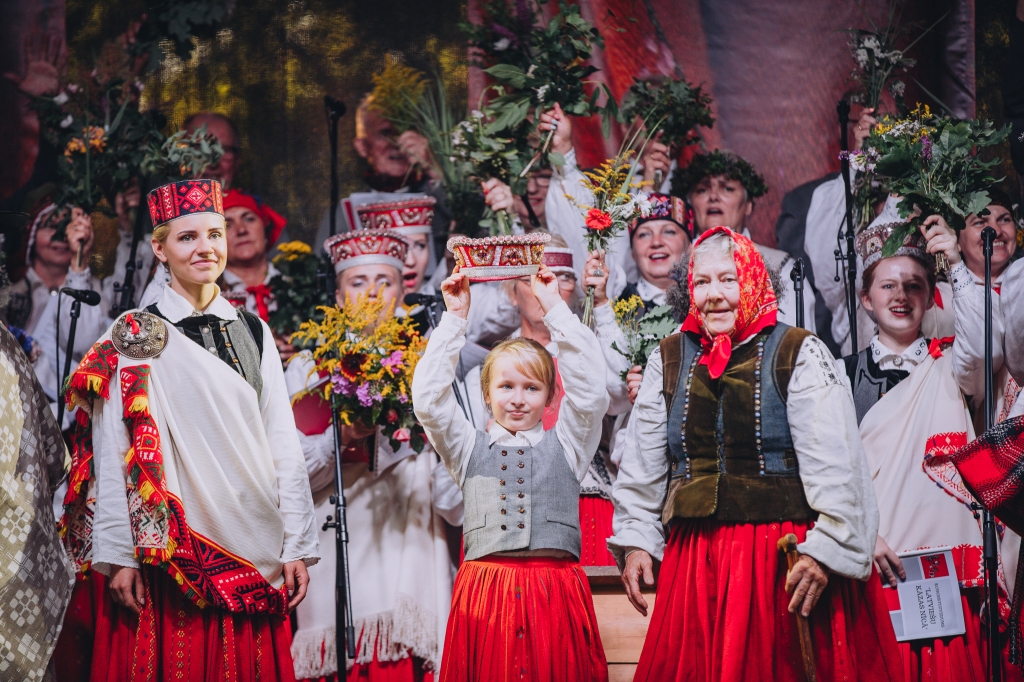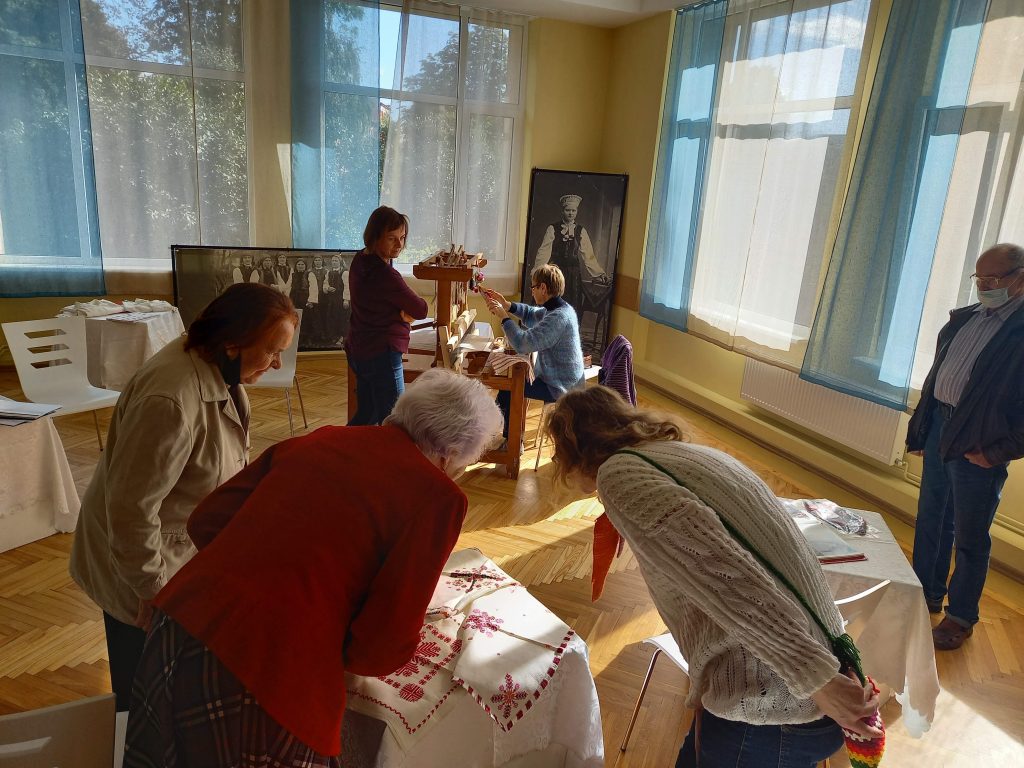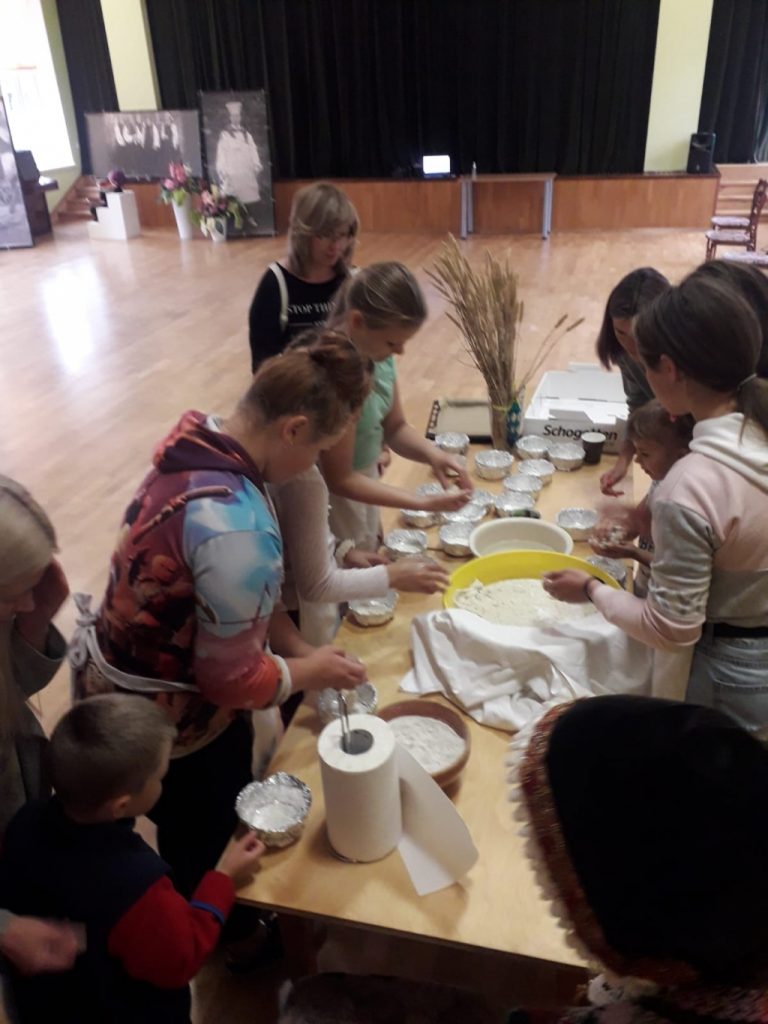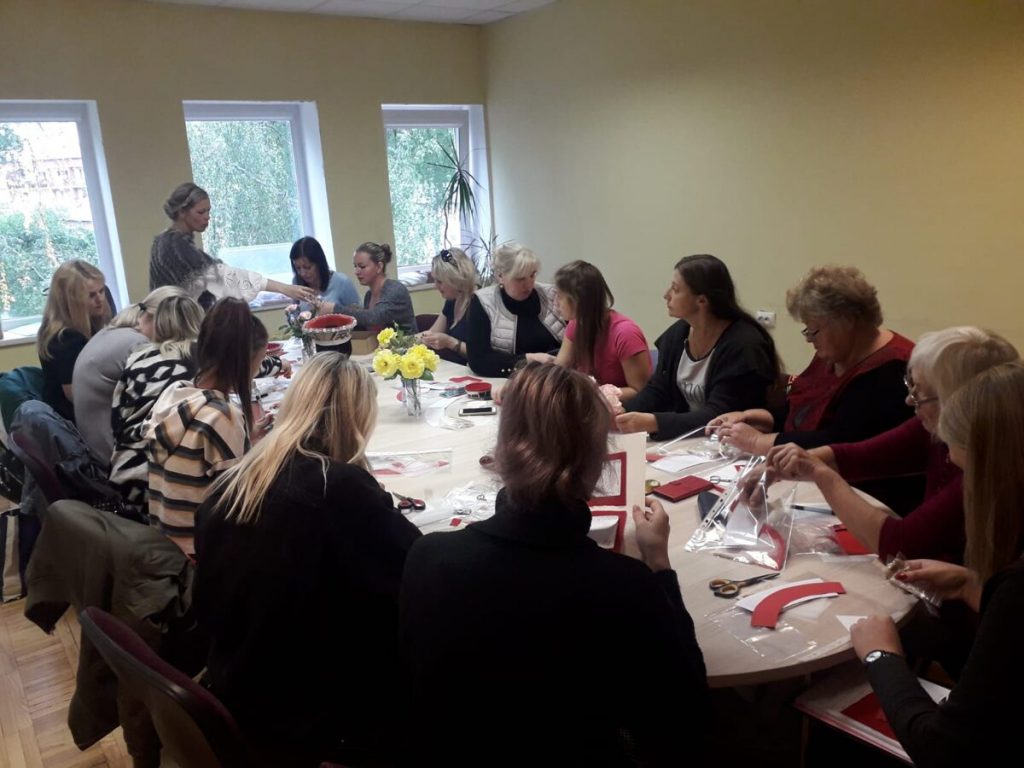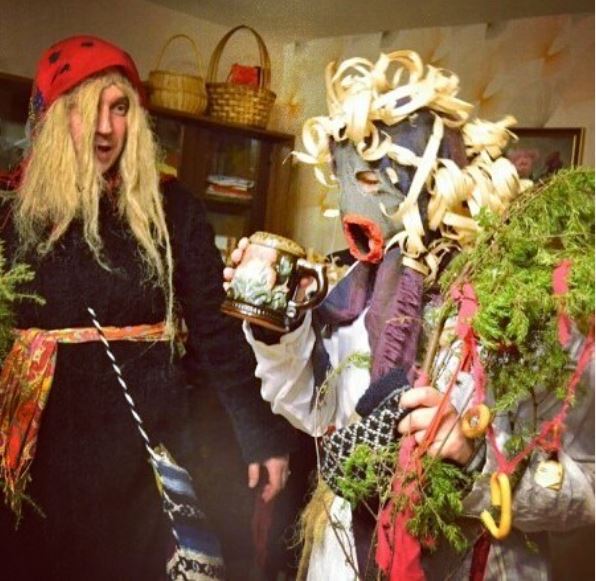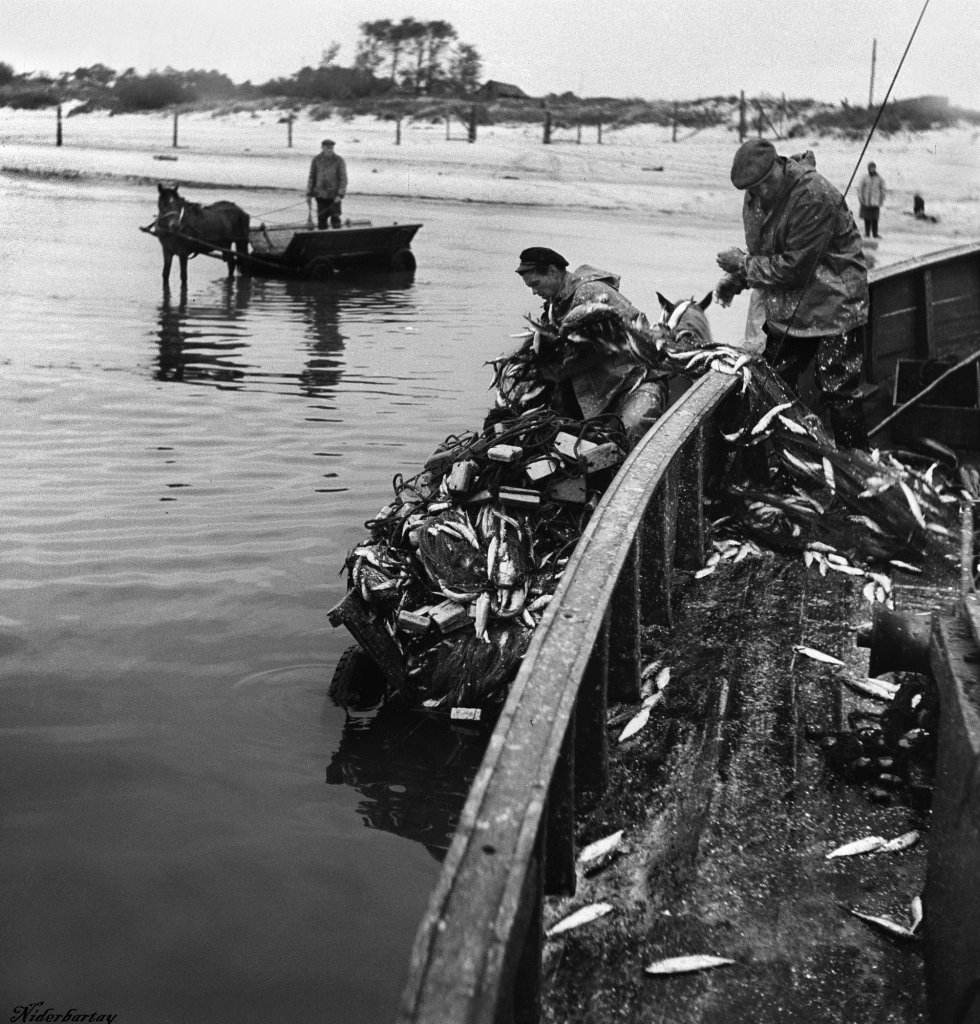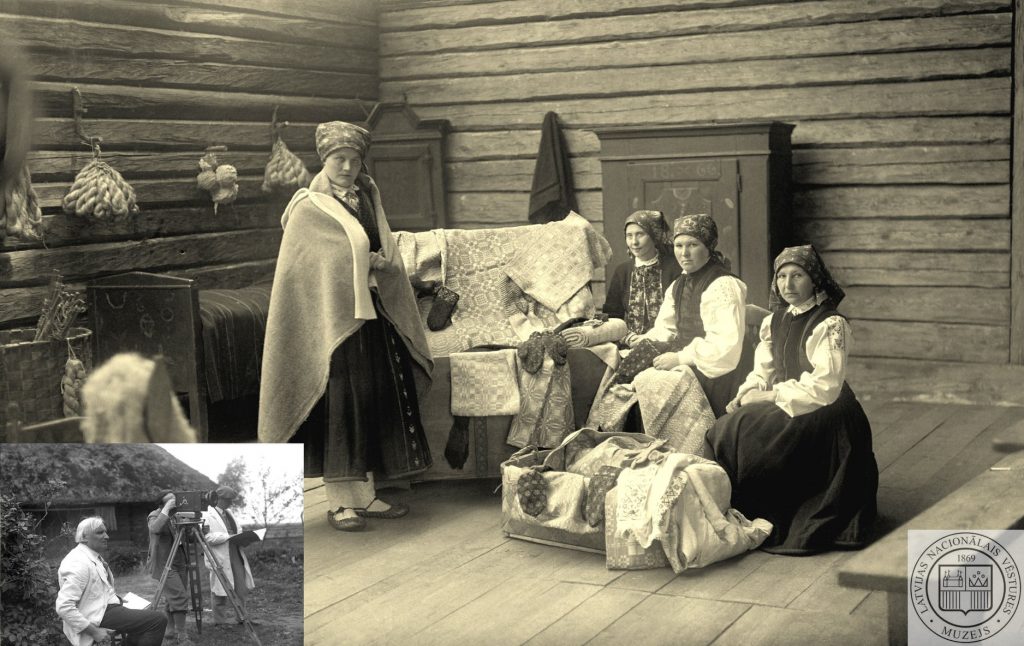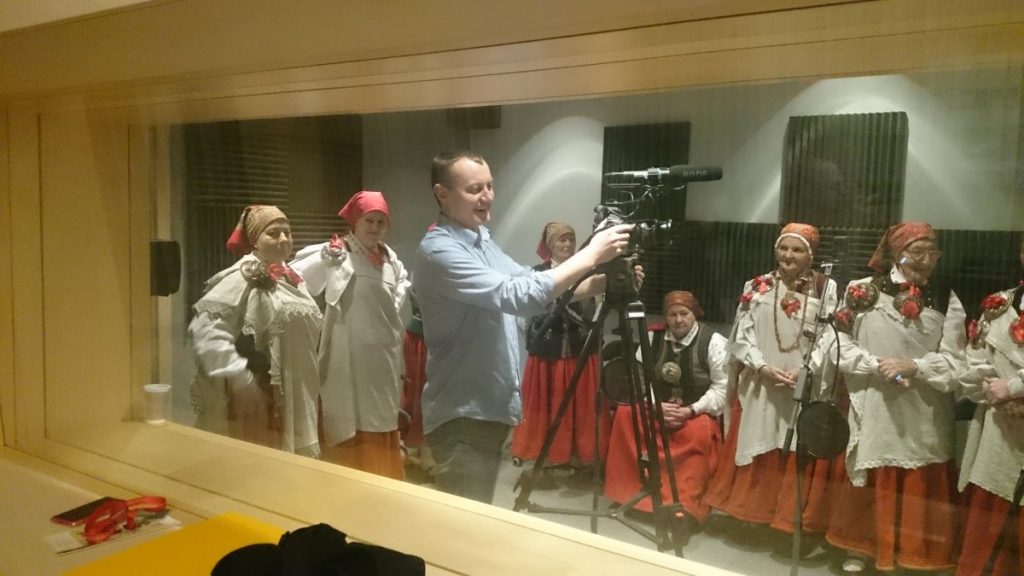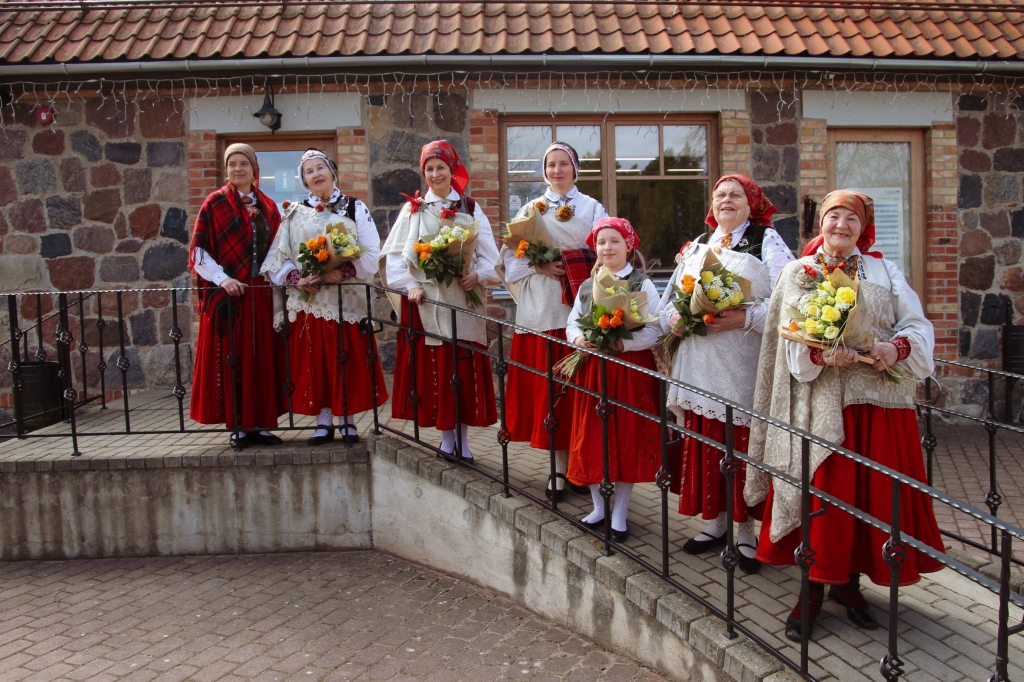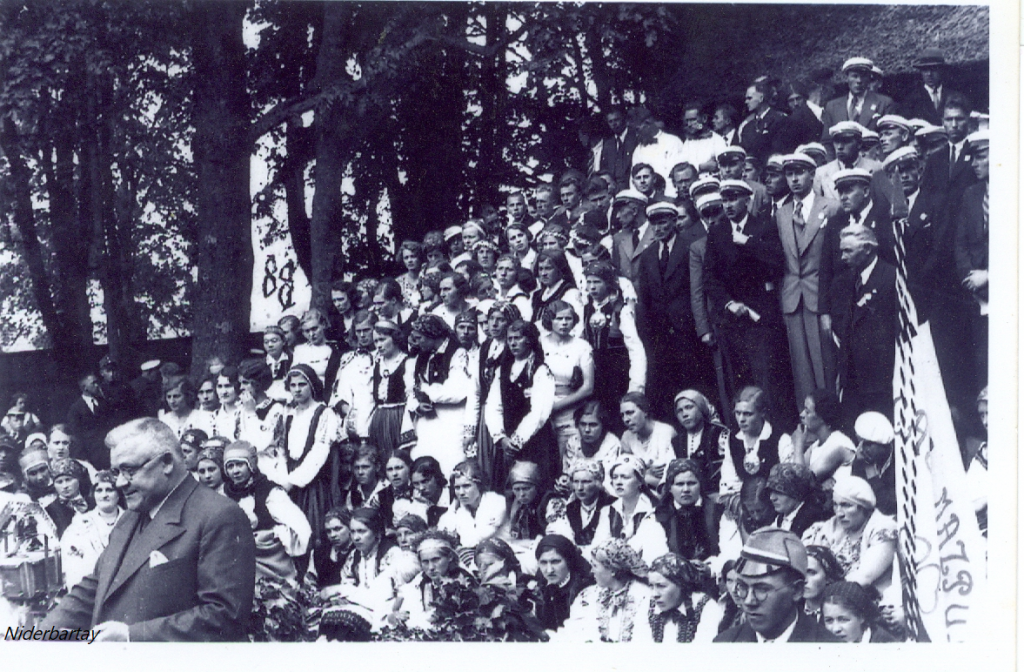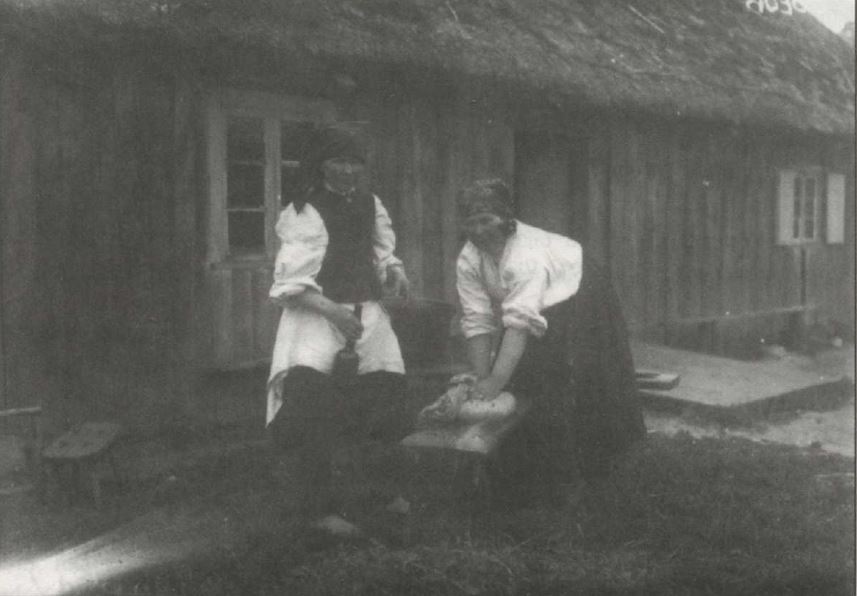Author:
Lelde Jagmina
Other domains
Oral traditions and their expressions, including language as a vehicle of intangible cultural heritage
Social practices, rituals and festive events
Music/performing arts
Traditional kitchen
Traditional craft skills
Knowledge and practices concerning nature and the universe
Title
Nīca cultural space (2022)
Nīca Cultural Space is located within the parishes of modern-day Nīca and Otaņķi, about 20 km from Liepāja city centre, between the Baltic Sea, Lake Liepāja, and the Bārta River. Nīca was established on the land of the former Nīca (Niederbartau: German) manorial estate, which is first mentioned in historical sources in 1560. Nīca natives are still proud of their bright folk costumes, customs, local dialect, and way of life. The traditional folk costume of Nīca not only features in the costume collections of almost all Latvian folkdance groups, but was also presented in 1947 as a wedding gift to Queen Elizabeth II of England on behalf of Latvia’s government in exile.
Geography
South Kurzeme Municipality, the Nīca parish and Otaņķi parish.
Nīca Cultural Space is made up of a community comprising local government officials of South Kurzeme, those with specialist knowledge of local culture, as well as the wider population of the parishes of Nīca and Otaņķi, who represent a diverse range of ages and backgrounds.
A large proportion of this 3,000-strong community has lent its support for the centre’s inclusion on the national register for Intangible Cultural Heritage. The community’s core, which still practices and keeps alive this cultural heritage on a day-to-day basis, is made up of the Nīca and Otaņķi Ethnographic Groups, the Nīca and Otaņķi Heritage Collections, as well as local craftsmen.
The most important members of this community are the Municipality of South Kurzeme, the Folk Tradition and Folklore Centre of South Kurzeme District Cultural Administration, the Nīca and Otaņķi Parish Association, Nīca Cultural Centre and Otaņķi People’s House, Nīca Secondary School, the associations “Nīcas novada attīstībai”, “Jūrmalciema valgums”, “Cerību krāsa”, “Kalnišķu Īves”, “Sabiedrisko mediju biedrība”, “Mēs – Bernātiem”, and “Bārtas upes radošā apvienība”, as well as the numerous families who take pride in belonging to Nīca and its traditions, practicing them within their family circles and living them through their daily activities.
A list of individuals, groups, and communities can be found at:
https://nicaskulturtelpa.mozellosite.com/par-mums/ar-nicas-kulturtelpu-saistititie/
Importance in Community Life
Visitors to Nīca regularly comment that traditions there permeate the air. The local residents perceive the daily practice of local traditions and festivals as a natural part of life, as the cultural area is formed by a diverse set of interconnected intangible cultural heritage units.
Through the planning and support of the activities of the Cultural Centre, the local government has ensured the preservation of elements of the cultural area of Nīca and has enabled opportunities for understanding and transmitting them. It supports the activities of local amateur artistic groups, including the purchase of traditional folk costumes. Male and female choirs and dance groups perform in Nīca folk costumes. Each year in the former Nīca region, newborns in Nīca and Otaņķi parishes, as well as the Citizen of the Year and the Honorary Citizen, were gifted the traditional “Burbuļsakta” brooch to serve as the basis of their future folk costume, to be completed during their lifetime. Even now, after joining South Kurzeme Municipality, celebrated citizens of Nīca and Otaņķi parishes are given the “Burbuļsakta”.
Work on supporting and developing amateur groups also continues. A special unit in the Department of Culture has been established to work with traditional cultural heritage.
Nīca Ethnographic group celebrated its 100th anniversary last year.
The Otaņķi Ethnographic group has also been recognised at an international level, being named the best in the Kurzeme region and sharing first-place nationally at the “Baltica 2022” folklore festival.
The Nīca and Otaņķi Heritage Collections not only preserve artefacts donated by residents, but also conduct in-depth local research. For example, at the Nīca Heritage Collection one can digitally explore, for free, one’s family tree, often tracing it back to the 17th century. Meanwhile, the Otaņķi Heritage Collection has, for the past two academic years, introduced first-grade students to cultural heritage through the “Historical Object of the Week” activity, led by a true Nīca native.
Since the 1960s, the Nīca dialect has had its own dedicated researcher, the philologist Brigita Bušmane, and work on a digital dictionary of the Nīca dialect is currently underway.
The residents of Nīca and Otaņķi are proud of their cultural and historical heritage, feel a strong connection to it, wish to preserve it, and often, even subconsciously, pass it on to future generations through their daily lives.
Activities
The Nīca Cultural Space is composed of a set of several intangible cultural heritage values:
1. The Nīca traditional folk costume, its crafting skills, and the tradition of wearing it. The folk costumes of Nīca and Otaņķi are visually very similar (Otaņķi Parish was only artificially separated from Nīca in 1949), yet each is unique due to differences in patterns. Today, local amateur groups, including folklore societies, regularly wear these folk costumes for performances and concerts. Occasionally, individuals may also wear the folk costume as part of a special event, such as at the Nīca Festival Parade, the visit and reception of the President of Latvia in Nīca, the “Folk Costume Parade” organised by “Senā Klēts” Folk Costume Centre, at traditional events held at the old “Galdnieki” homestead in Pērkone, as well as the costumes also being part of the heritage collections of both parishes. The Nīca folk costume is also regularly worn to represent Nīca and Otaņķi parishes at cultural and tourism events. Community members are happy to entrust their inherited costumes to the two heritage collections, though around 150 households have been identified where families carefully preserve or have crafted from scratch a Nīca folk costume or some of its elements.
2. The Nīca dialect. Part of the Lower Kurzeme dialect group, the dialect of Nīca has a distinctive pronunciation, for example: the use of a broad “e”; diminutives of nouns and adjectives ending in “-īns”, “-īna”, instead of “-iņš”, “-iņa”, e.g. māmīna, meitīna, maģīns, vīrīns, labīns, bērnīns; in past tense verbs, an old ending “-e” is preserved, e.g. “kave” for “kāva” (‘struck’), “deve” for “deva” (‘gave’), and “nāce” for “nāca” (‘came’); polysyllabic verbs with an “-ot” ending change, in the past tense, to “-ava”, as in “Zvejnieki jūrmalā ilgi rēkava un prātava, ko darīt: iet jūrā, vai nē, bet kad daži galvava un beidzot pat nobalsava, ka vētras nebūs, tad gāja jūrā un zvejava” (“The fishermen on the shore talked for a long time and wondered what to do: whether to go to sea or not, but when some of them argued and finally even voted that there would be no storm, they went to sea and fished”); in reflexive verbs, double reflexive pronouns appear, one at the end of the word and another between the prefix and the verb itself, e.g. “dadzis piesakārās pie drēbēm” and “šī skuķe ir dikti pasalaidusēs”; nouns and adjectives also have an instrumental case ending “-is”, such as in “Mīļis vārdis tautu dēls / Noņem manu vainadzīnu[...]”, “Puisis dodas lielis soļis”, “Viņš ir rītis, ir vakaris pie darba”, “Kaimiņš atbrauca ar dižis zirgis”; a broken intonation, for instance, instead of saying “Nīca” with a lengthened “ ī ”, the pronunciation is “Nī-ca”, with a short emphasis, as if “broken” in two, a phenomenon which occurs within sentences as well, for example “Viņš vilka atspēries”, where “at-spēries” is split with a slight pause; and vocabulary, including regional words such as “knausis” (‘gnat’), “āzbars” (‘groats’), “dātali” (‘gifts’), “bambalis” (‘beetle’), “subine” (‘backside’), “bruzda” (‘noise’), “pumpas” (‘buttons’), “čapatāt” (‘to walk’), “apguģināt” (‘to cover’), “bīstāklis” (‘stick for poking coal in the stove’), “pakacēt” (‘to hand or pass’), “naģe” (‘frog’), “ķirmēt” (‘to pine away’), “ķocis” (‘basket’), “skutuls” (‘bowl’), “rācenis” (‘potato’), “smakaris” (‘chin’), “ķenkles” (‘thighs’), “dzievāt” (‘to work’ and ‘to live’), “čekls” (‘diligent’ and ‘beautiful’). The Nīca dialect is still actively spoken among many residents of Nīca and Otaņķi, with the younger generation also inheriting it.
3. The polyphonic singing of Nīca, especially the “long call” followed by the “leitis”, is notable. Drone singing (bourdon) is primarily found in seasonal celebrations and traditional family songs, and is connected with transitional rituals (such as wedding songs with sung exchanges or “apdziedāšanās”). The diversity of melodies unique to Nīca has been preserved to this day through direct oral transmission—by singing in families and in ethnographic groups. Locals still remember that after finishing each major task, the long call had to be sung, immediately followed by a variation of the “leitis”. Today, the singing style characteristic of the Nīca area is mainly heard in performances by the Nīca and Otaņķi ethnographic groups and at various public events.
4. The folklore recorded in Nīca and the surrounding areas includes beliefs, legends, and games, such as the funeral games “Zvejnieku amats” (‘The Job of the Fisherman’) and “Sieviņ’ brauca mežā, vīrs palika mājās” (‘The woman went into the forest, the husband stayed at home’).
Beliefs include a tradition that when a child loses a milk tooth, it should be thrown onto the stove saying, “Še, pelīte, piena zobs, atnes manu kaula zobu!” (‘Here, little mouse, a milk tooth, bring me my bone tooth!’) Another belief holds that if a girl eats the “knipselis” (‘ends of bread loaves’), she will marry the son of a landowner. If a girl steps into her skirt instead of pulling it over her head, she won’t find a husband. At the beginning of summer, after hearing the first clap of thunder, one can sit on the ground, after the second, lie down, and after the third, go swimming. On the first herding day in spring, if the entire household, including the shepherd, sprinkles one another with water, the shepherd will stay alert while herding, and the animals won’t stray into the crops. Masking and mummery during February bring blessings, fertility, and prosperity to both the house visited and even more so to one’s own home.
Among popular legends are those about the origins of the colours in the Nīca, Bārta, and Rucava folk costumes, and about the coastal dunes of Jūrmalciems, Pūsēni Hill and Ķupu Hill. Proverbs and sayings still in use include: “Tas vēl nav zvanīts [kuros kapos glabās]” (‘It hasn’t yet been rung [in which cemetery they’ll be buried]’), meaning a decision is not final; “Tā kā bīstāklis pa kājām” (‘Like a coal poker in the way’), if something is positioned inconveniently; and (from Jūrmalciems), “Izplēties kā ciekurzis [uz mūrīša]” (‘Spread out like a pinecone [on the hearthstone]’), among others.
5. Crafts and lifestyle traditions. In Nīca and its surrounding areas, these traditions, which are rooted in an age-old homestead lifestyle and the use of local natural resources, have shaped successive communities of both farmers and coastal fishermen, and are still observed today. The beginning and end of the work season are marked, and communal work gatherings are organised. Each year during the “Buls” period (the off-season for fishing, in July, when the weather is hot and fish are in deeper waters), the Fishermen’s Festival is celebrated in Jūrmalciems. In homesteads that keep cows, people sprinkle water on one another on the first herding day of spring. For farmers and livestock-keepers, the protection and health of crops and animals remains important, so at the start of the new farming year in February, households happily welcome masked visitors (“ķekatnieki”) to bring blessings. After completing a major task like harvesting potatoes, the elders encourage the younger ones to give the long call, which is followed by a larger feast.
6. Festival traditions. Among the most characteristic seasonal celebrations in the Nīca area are Jāņi (Midsummer) and Meteņi, or mummery on the eve of Ash Wednesday, usually in February, marking the beginning of the agricultural year. Family ceremonies are still celebrated, including christenings (formerly called “krustabas”, now “kristības”), weddings, and funerals, each with its own specific sequence of events (ritual acts, songs, melodies, etc.) and unique attributes (such as offering gloves, funeral gloves and blankets, and the use of special musical instruments such as the “ērkulis”).
7. Culinary heritage. In Nīca, housewives still make firm cloth-bound cheese from skimmed milk for Jāņi, with “nine corners” (creases from the cheese cloth), and a raised centre intended for Jānis himself. Some households also continue to bake rye bread, fine-rye bread, various “rauši” (‘sheet cakes’), and “kāršelis” (a flatbread made from rye dough with a topping, usually a mixture like sugar and cream, or herring or meat (“speķis”) and salt, and baked in the bread oven before the main bread is baked), as well as “pīlīte” (a small loaf with meat). “Sklandrauši”, “skābputra”, and ‘white butter’ – called “leitis” in this region – are also popular dishes among the people of Nīca. Additionally, housewives often prepare snacks from rye flour called “spiras”.
More information on each of the traditions mentioned above can be found here:
https://nicaskulturtelpa.mozellosite.com/
Beliefs, Rituals, Unwritten Rules
1. In the cultural area of Nīca, there are unwritten yet strict rules for assembling and wearing traditional folk costumes. These guidelines have been passed down orally by older women, often members of ethnographic groups, to subsequent generations. These rules are also well-known and promoted by staff at the Nīca and Otaņķi Heritage Collections, who are local residents themselves. Leaders of community artistic groups are actively interested in and practice these traditions. A few examples of these rules include:
* The Nīca crown is to be worn only by a young woman who is ready for marriage, up until her wedding; afterwards, she wears a scarf (“drānele”) or a cap (a crown hat or bonnet).
* The “villāne” (large shawl) and “pamuve” (skirt) must fit snugly at the waist and should not hang loose; the villāne is never worn for dancing, as it is considered outer-clothing.
* The folk costume must be worn publicly only in its entirety (for example, one should not wear only the skirt (“lindruks”) without the vest (“burste”), or similar combinations).
* Hair must always be neatly gathered. If wearing a crown, hair should be braided in a classic three-strand braid with a red or green ribbon that hangs loose, without decorative tying.
* The skirt (“lindruks”) should reach mid-calf, so that the beautiful stockings (“caurlielenes”) are visible.
* Brooches should not be pinned lower than the chest.
* When creating the costume and accessories, specific patterns and colour combinations must be observed, however items should not be identical. There must be variation in patterns or their arrangement, especially in the designs of skirts, shirts, shoulder straps, and ceremonial handkerchiefs (“nēzdaugi”).
2. When finishing up an important task, the “garais sauciens” (‘long call’) is always sung; it is always followed by “leitis”. This is observed by the participants of both ethnographic groups when performing and representing the Nīca ethnographic area.
3. On the eve of Ash Wednesday, people should take part in mummery (“ķekatas”) to ensure luck and fertility, while also bringing it to the residents of the houses they visit. Nowadays, only the members of the Otaņķi ethnographic group go on “ķekatas”, but they visit local residents outside the group and are welcomed warmly.
4. On Jāņi (Midsummer), the owners of homesteads who welcome “jāņabērni” (midsummer guests), decorate corners of their rooms with “meijas” (young birch trees), which are then formed into sauna whisks that remain green and firm and do not shed their leaves for a long time; they craft and burn a “pūdele” (a firewood-filled barrel on the top of a pole); traditional foods like caraway cheese, flatcakes, and beer are served; a big bonfire is made and the young people stay up waiting for sunrise.
5. At Easter, the family cooks eggs in onion peel and other organic materials; at sunrise, they wash their faces in running water; egg battles are held; and people swing on swings.
Inheritance and transmission
The elements which make up the Nīca Cultural Space are passed on primarily within the family, and also by relatives, neighbours, and friends. Local municipalities and educational institutions also bring the Nīca Cultural Space to life and keep it relevant from a young age, including, until recently, at the “Spārīte” preschool in Nīca, along with its branch in Rude, in the parish of Otaņķi, and the former Rude Primary School, which was closed in 2020 after 145 years of active work. Additionally, a number of well-prepared students have graduated from Nīca Secondary School over its more than 80-year history.
The municipality provides creative groups (including both of the ethnographic groups) with rehearsal spaces and well-equipped, modern cultural venues, where they can delight both local residents and guests with concerts and other events. Additionally, the municipality covers the groups’ transportation, catering, and accommodation costs while representing the Nīca Cultural Space at national and international levels. The Otaņķi ethnographic group practices the transmission of folklore inherited from parents and grandparents during concert discussions. The Nīca ethnographic group visits educational institutions with games and stories appropriate to the seasonal celebrations. Participation in at least one ethnographic group ensures the regular and meaningful use of ancient practices, fostering an understanding of their application and inheritance.
Going on “ķekatas” is practiced only by the Otaņķi ethnographic group in collaboration with the local inhabitants, who are still very familiar with the tradition and welcome the “ķekatas troupe”. A digital album of ķekatas songs will be recorded this year.
The Nīca and Otaņķi Heritage Collections have prepared a comprehensive and extensive collection for each aspect of the Nīca Cultural Space, which continues to be researched and enriched in collaboration with the older residents of Nīca and their families. Requests for new research topics come from residents who have recently purchased or inherited property in the Nīca region (such as the history of houses, door designs, well designs, etc.).
The future Craft House at the Otaņķi Heritage Collection is responsible for the inheritance of the Nīca folk costume and its accessories. This is also carried out by the group of handcraftsmen “Vēlziedes” and individual artisans. The Otaņķi People’s House plans to digitise culinary heritage.
Agricultural and coastal fishing skills, as well as culinary heritage, are passed down from generation to generation within families, particularly in the region’s large farming homesteads.
The municipality, in collaboration with industry associations, organises the filming of work processes and interviews.
More information: Supplementary materials.
History
Before the establishment of the Latvian state, Nīca was referred to in official documents as “Niederbartau”, as well as “Nīce” and “Nīcava”. The name “Nīca” reflects the geographical characteristics of the area—it is located in the low-lying coastal plain at the lower reaches of the Bārta River. The first topographic map to feature Niederbartau (Lower Bārta) was printed in 1560. Excavations of the Curonian burial mounds in Nīca indicate that the area was inhabited as early as the 10th to 12th centuries. The coastal area, specifically the village of Paipi (Pemis, Peynis) and the area in the vicinity of Virga cemetery, in modern-day Jūrmalciems, is mentioned in a document from July 20, 1253, issued in Kuldīga regarding Duvzare, which, at that time, included the territory of present-day Nīca. In general, historical sources indicate that the Baltic Sea coast as far as the Venta and Abava rivers is recorded as the entry point for the Balts into modern-day Latvia in around 2500–2000 B.C.
A significant role in the study of the Nīca dialect was played by the German-Latvian linguist Jānis (Johann) Langijs (1615(?) – 1690(?)), who served as the assistant pastor in Nīca and Bārta. In the late 17th century, Langijs compiled a Latvian-German dictionary with a brief Latvian grammar included as an appendix.
The first publications of Nīca folksongs can be found in the collection “Latvian Folk Songs and Chants”, compiled by G. F. Bitner (Jelgava, 1844), which includes 21 folksongs recorded in Nīca. Subsequent publications include 764 songs recorded in Nīca (covering the territory of modern-day Nīca and Otaņķi parishes). Some of these (364) were submitted by the Nīca teacher M. Spriņģis. These more than 700 songs were included in “Latvju dainas”, compiled by Krišjānis Barons and Henrijs Visendorfs, which were published from 1894 to 1915 in Jelgava and Petrograd.
The 16th and 19th volumes of the Riga Latvian Society’s Knowledge Commission (1929) contain information about weddings, baptisms, seasonal celebrations, and gatherings in Nīca. The authors of these works are Ignāts Bierands, Kārlis Lielozols, and Margrieta Ignāte. A systematic collection of songs heard in Nīca took place in the second quarter of the 19th century. The Folklore Department of the University of Latvia’s Institute of Literature, Folklore, and Art, holds over 23,000 variants of folksongs heard or recorded in Nīca.
In around 1970, philologist Brigita Bušmane began researching the Nīca dialect and, in collaboration with local speakers and teachers, published the book “Nīcas izloksne” (‘Nīca Dialect’) in 1989.
In Nīca, every gathering of people during celebrations has singing at its heart, which is why the formation of the Nīca Ethnographic Group is recorded in around the year 1920. In 1953, the group was tasked with preparing an ethnographic performance titled “Latvian Weddings in Nīca”, intended to be presented at the Decade of Latvian Arts and Literature in Moscow in 1955. The group, consisting of 70 members, fulfilled its task with great success. All participants received awards.
The Otaņķi Ethnographic Group was established in 1964 to honour the retirement of the senior members of the “Zelta Zvaigzne” kolhoz. Under the leadership of Rasma Atteka (née Ignāte), the director of Rude School, and Reinholds Jansons, the then-leader of the Nīca Ethnographic Group and a teacher at the seven-year-old Nīca school, local women decided to stage “Nīca Weddings”. Since there was barely enough space in the club for the audience at the time, the performance was shown multiple times – both to other local residents and in neighbouring parishes and towns.
The Nīca Local History Centre and Heritage Collection was established in 2010, although, prior to that, it was possible to explore the private collection of its director, entitled “The Antiquities of Jūrmalciems”.
In addition to the diverse costumes and tools from Nīca, photographs, and life stories, Gita Vanaga’s greatest achievement is the compilation, digitisation, and continuous enhancement of the Nīca family trees (in collaboration with the residents of Nīca themselves).
The Otaņķi Heritage Collection was established in 2001, thanks to the creation of the Rude School Museum, when local residents shared photographs and items that were not related to the school. The collection houses folk costumes, household items, ancient tools, and even horse tack. The Otaņķi Heritage Collection and its volunteers actively engage on social media platforms like Instagram and TikTok, promoting the ancient traditions of Nīca throughout Latvia.
Agriculture remains the primary livelihood for the residents of Nīca and Otaņķi Parishes, often serving as an additional source of income alongside jobs in state and municipal institutions, as well as in companies in Liepāja or Grobiņa. Coastal fishing still has its place and is valued, although it is practiced by fewer people, with the downside being that it is a seasonal occupation. Residents continue to inherit craft skills, such as blacksmithery, carpentry, weaving, basket making, and knitting. Several skills and trades are practiced for recreational or tourism purposes, such as smithery and horse husbandry, which, until recently, were essential and invaluable professions.
The Nīca folk costume is no longer worn every Sunday to church or at weddings, however it is regularly worn by local artistic groups of all ages representing their parish, as well as by individual nominees, their congratulators, and award presenters during the annual events honouring the residents of Nīca and Otaņķi, at traditional events, special family celebrations, and when hosting special guests, including those from far afield. Both the ancestral costumes and those newly made and assembled hold high aesthetic value. The Nīca Tourism Information Centre of the South Kurzeme Municipality uses the Nīca folk costume in visual and video materials as well as printed works. When representing Nīca or Otaņķi, it is an integral part of the story, just like songs, local bread, and cheese, along with the other traditions.
The Nīca dialect and local dialect words can still be heard in nearly every household and they also quickly “stick” to newcomers from other areas.
The Nīca long call and the “leitis” can be heard during the rehearsals and concerts of the Nīca and Otaņķi Ethnographic Groups, and sometimes among local people in “song battles”. A generational change is gradually taking place within the ethnographic groups, but, during concert discussions, the local audience and potential new members are still always “trained” to some extent, and they do recognise the genre’s terms and melodies. Every year, an event called “Dienvidkurzemes daudzbalsības daudzinājums” (Polyphonic Chanting of South Kurzeme) is organised, where the inheritors of this tradition – the Nīca, Otaņķi, and Bārta Ethnographic Groups – each take it in turns hosting. By attending lectures from ethnomusicologists, they enhance their skills and familiarise themselves with the uniqueness of the region and the local variations of songs during concerts.
Overall, the traditions of Nīca (such as the dialect, wearing of folk costumes, etc.) can today be said to shape the identity and self-esteem of the local people, reinforcing their sense of belonging to the Nīca Cultural Space. On the other hand, local traditions are used as a way of representing the area—through tourism, events, etc.—which in turn strengthens the identity of the place and builds its recognition.
Additional Information
It is known that the Nīca folk costume is one of the most popular folk costumes made and worn among Latvian expatriates worldwide. On the wedding day of Queen Elizabeth II of England, November 20, 1947, Kārlis Zariņš, a representative and envoy of the Latvian government in exile, presented her with a wedding gift on behalf of Latvia – a complete set of the Nīca folk costume.
Nīca heritage has also been a source of inspiration for creative works.
Music:
Composer Raimonds Pauls’ choir songs (2016), “Nīcas dziedātājas pirtnieku mātes piemiņai”, which is a poem by Imants Ziedonis from the poem collection “Caurvējš” (1975): https://koris.lv/rozes-gars/ This in turn resulted from the friendship with the Otaņķi Ethnographic Group and the local population.
Education and tourism:
The Nīca municipality tourism centre created an ethnographically accurate paper doll, the Nīca girl, and added the local names for the garments to the clothing (e.g. lindruks, burste, vaiņags): http://www.papiralelles.lv/kolekcijas/lelles-latvijas-novadu-tautasterpos/pr/ieva-no-nicas-novada.html.
Fashion, interior design:
* The Karelsshop.com sells silk scarves with a printed copy of the pattern of the ethnographic mittens of Nīca
* Latvijastekstils.lv sells interior objects and accessories (towels, cups, tote bags, pillows, mobile phone cases) with Nīca ethnographic motifs
* Artist Andra Gulbe created an illuminated art installation in 2012 – “XXL” – a large lamp in the form of a Nīca crown, which can be seen in the Museum of Applied Arts and Design
* The sculpture “Dark-Skinned Folk Maiden” by sculptor Aigars Bikše, dressed in the Nīca folk costume, was displayed in the exhibition “Mobile Museum. Next Season” at the Art Park in Riga in 2022, and previously as part of the 2016 Liepāja Art Forum, among other events
Masters
Special traditions and craftsmen (in alphabetical order) of particular note and importance in the Nīca Cultural Space:
Ambrēna Inta – embroiderer (Nīca shirts, special handkerchiefs): FAAS “Liepava” participant.
Dilēviča Velta – creator of elements of the Nīca folk costume (buršlaki, Nīca knitted jackets, women’s hats, shirts): Studio “Latva”, Liepāja.
Drāznieks Andrejs – weaver: “Mūrēni”, Otaņķi parish.
Dzintare Ausma – traditional homestead owner, tourism entrepreneur: “Galdnieki”, Pērkone, Nīca parish.
Jagmina Lelde – local historian, compiler of “Nīcas un Otaņķu pagastu tautasdziesmu krājums” [Collection of Folksongs from Nīca and Otaņķi Parishes], Otaņķi parish guide: “Pļavmalas”, Rude, Otaņķi parish.
Jekste Guntis – carpenter (table designer): “Pērkones Zvejnieki”, Pērkone, Nīca parish.
Kadeģis Oskars – a sixth-generation coastal fisherman: Fisherman's house “Oskars”, Jūrmalciems, Nīca parish.
Kalniņa Regīna – knitter and weaver of elements of the Nīca folk costume, and a promoter of the skills involved in creating the Nīca folk costume: “Agri”, Nīca, Nīca parish.
Klāsēna Maira – local expert, specialist in the characteristic singing style of Nīca, as well as a custodian of Nīca’s culinary heritage, member of Otaņķi Ethnographic Group: Ķezberes, Otaņķi, Otaņķi parish.
Krētainis Valters – carpenter in Jūrmalciems: “Nīckrasti”, Nīca, Nīca parish.
Kupšis Arnis – miller at the Prenclavu mill, carpenter: “Otaņķi”, Otaņķi, Otaņķi parish.
Maļika Velta – local expert, specialist in the characteristic singing style of Nīca, former member of the Otaņķi Ethnographic Group and current member of the Nīca Ethnographic Group: “Upītes”, Nīca, Nīca parish.
Prenclava Ilga – local expert, specialist in the characteristic singing style of Nīca, member of the Otaņķi Ethnographic Group: Otaņķi, Otaņķi parish.
Rubeze Smaida – weaver: “Arāji”, Bernāti, Nīca parish.
Rumkovska Inta – horse husbandry and horse tack expert: “Ērkuļi”, Laukgals, Otaņķi parish.
Sileniece Aija – weaver, knitter, member of Nīca Ethnographic Group: Nīca, Nīca parish.
Skalde Daina – cloth cheese-maker: “Vārpas”, Rude, Otaņķi parish.
Skrieders Ivars – master of amber processing and kniepķens ([‘brooch’]): “Zāži”, Jūrmalciems, Nīca parish.
Škuberte Ilze – weaver (Nīca ceremonial pocket handkerchiefs, drēļļi, and woven textiles): member of TLMS “Liepava”.
Vaitkusa Agra – weaver (linen and wool products): “Splītes”, Rumbasgals, Otaņķi parish.
Vanaga Gita – local expert, local historian, author of books, expert on Jūrmalciems fishing traditions and Nīca household traditions, guide: “Jasmīni”, Jūrmalciems, Nīca parish.
Vārna Alīda – local expert, local historian, cloth cheese-maker, baker of bread using recipes passed down through generations, compiler of “Nīcas un Otaņķu pagastu tautasdziesmu krājums” [Collection of Folksongs from Nīca and Otaņķi Parishes]: “Vēķauši”, Banažgals, Otaņķi parish.
Vecbaštika Arta – traditional homestead owner, horse breeder, tourism entrepreneur: “Ciestomi”, Jūrmalciems, Nīca parish.
Ziemelis Arvis – experienced coastal fisherman who has taught the craft to his now-adult sons.
Institutions and Organizations
Municipality of South Kurzeme
South Kurzeme Municipality Cultural Department, Centre for Folk Traditions and Folklore
Nīca and Otaņķi Parish Administration Union
Nīca Cultural Centre
• Otaņķi People’s House
Nīca Heritage Collection
Otaņķi Heritage Collection
Nīca Preschool “Spārīte” and its branch in Rude
Nīca Secondary School
Folklore Group “Rakari” of Nīca Secondary School (Grades 1–4 and 5–10) and folk dancers (Grade 1 and Grades 2–4).
Nīca Music School
Nīca Youth Centre
Nīca Municipality Development Association.
“Cerību krāsa” Association
“Jūrmalciema valgums” Association
Jūrmalciems Residents’ Initiative Group “Aizjomietes”
Interest Group “Kalvas”
Interest Group “Vēlziedes”
Interest Group “Rude”
Interest Group “Stars”
Nīca Tourism Information Centre
"Sabiedrisko mediju biedrība"
“Kalnišķu Īves” Association
“Mēs – Bernātiem” Association
“Bārtas upes radošā apvienība” Association
“Otanka” Association
Strengthening the Tradition
In order to ensure the existence of the Nīca Cultural Space books and musical records have been issued over the past five years, educational events and concert performances have taken place, short films have been created, and the traditions of Nīca have been promoted at local, national, and international levels. Several infrastructure projects have also been implemented.
17.09.2022: The Nīca Development Association secured €1,500 from the Kurzeme Cultural Programme and organised the “Polyphonic Chanting of South Kurzeme” event at Otaņķi Community Centre. This event featured the Nīca, Otaņķi, and Bārta Ethnographic Groups and their future successors—the local children’s and youth folklore groups. During the event, participants explored and practiced the tradition of local song performance in drone polyphony.
06.–20.09.2022: An inventory was carried out to identify the current owners of traditional and newly made Nīca folk costumes or their components (such as socks, skirts, and crowns), with the aim of creating a compilation of family folk costume stories.
12.–18.09.2022: The Tīklu māja museum in Jūrmalciems hosted a pop-up exhibition from the Liepāja Museum, featuring documentary photographs from the museum’s collection on coastal fishing in the 1920s and 1930s in Liepāja and nearby villages, including Pērkone, Pape, Bernāti, Nīca, and Jūrmalciems.
01.09.2022: Nīca Cultural Centre received a woven Nīca Ethnographic Group flag, valued at €1800.
26.05.2022: The South Kurzeme Municipality secured €1300 from the State Cultural Capital Foundation (VKKF) for the publication of the digital album “Ciemā lēcu ķekatās” (“Visiting Village Mummers”).
06.04.2022: Printed and bound copies of philologist Brigita Bušmane’s digital dictionary of the Nīca dialect (spanning 1,000 pages up to the letter “Ķ”) are now available for reading at the Otaņķi Parish Library and the Nīca Heritage Collection (cost: €90.00).
30.03.2022: In collaboration with the Kurzeme Institute of Humanities and the Cultural Heritage Department of the South Kurzeme Municipality, a video about the Nīca dialect has been created (€180.00).
21.02.2022: Ethnographic shoe replicas were received, ordered for the amateur performance groups of the Nīca and Otaņķi cultural institutions.
15.01.2022: For the third consecutive year, decorative flags featuring Nīca ethnographic mitten patterns – seasonally themed – were placed on lampposts in Nīca and Otaņķi parishes (€2,500.00).
05.12.2021: A large-scale illuminated installation, “Nīca Crown”, was installed in Nīca Parish Centre, designed to create a unified festive design concept, “Nīca’s Crown in Moonlight”, across Nīca and Otaņķi parishes during the darkest months over the next five years (€1,800.00 with an additional €12,000.00 planned for the coming years).
October 2021: Prior to COVID-19 restrictions (also in 2019, in the now-closed Rude primary school 1st grade), “Historical Object of the Week” sessions in both 1st grades at Nīca Secondary School, weekly meetings with a traditional Nīca resident to discuss topics like lanterns, basket-weaving, Nīca crowns, brimmed hats, etc. Activities included sowing seeds, decorating crowns and hats, blowing air into lanterns , etc.
30.09.2021: Video entries of the Nīca and Otaņķi Ethnographic Groups were created for the international folklore festival “Baltica 2022”, including a short film on the “Krustabas tradition” (€1,870.00).
04.09.2021: Collaboration with the Liepāja Museum, Nīca and Otaņķi Heritage Collections, and ethnographic groups from Nīca, Otaņķi, Bārta, and Rucava, alongside TLMS “Liepava” weaver Ilze Škuberte, embroiderer Inta Ambrēna, and local residents, participating in the LNKC event “Meet Your Craftsman!” The theme was the ethnographic “nēzdaugs” (ceremonial pocket handkerchief) with a lecture, discussions, and weaving demonstrations (€90.00).
Summer 2021: Creation of a short film on coastal fishing traditions in Jūrmalciems, Nīca parish, accessible online:
https://www.youtube.com/watch?v=4r-N2XrjOxA
Summer 2021: Otaņķi locals Ilga Prenclava, Maira Klāsēna, Alvīne Šķipere, and Lelde Jagmina participated in an expedition by the association “Serde” to document the traditional dishes “skābputra” and “sklandrauši”.
15.06.2021: Lecture by Ilga Reizniece, “Experiencing Midsummer”, in the Rude school’s open-air auditorium with Nīca and Otaņķi Ethnographic Groups (€250.00).
15.06.2021: Short films (with subtitles) “Nīca Folk Costume” and “Nīca Singing Styles” created as part of a submission to the Latvian National Intangible Cultural Heritage List (€760.00).
04.05.–30.06.2021: Multimedia exhibition “Folksong Singers. 1991” featuring Otaņķi locals Margrieta Otaņķe and Katrīna Radomišķe at the Otaņķi Community Centre (€1,000.00), with a virtual tour available:
https://www.youtube.com/watch?v=UMNLOzcB7i0
https://www.youtube.com/watch?v=UMNLOzcB7i0
26.03.2021: Prepared and published “20 Gems” from the Otaņķi Heritage Collection on kultura.nica.lv to celebrate its 20th anniversary.
2020: Six songs were professionally recorded by the Nīca Ethnographic Group and one by the Otaņķi Group (€2,000.00).
Three short films were produced, on the history of the Nīca Ethnographic Group (€550.00), the Krustabas tradition with the Otaņķi Group (€1,800.00), and the coastal fishing tradition in Jūrmalciems (€200.00).
30.11.2020: Electricity connection in the future Nīca Craft House – the Otaņķi Heritage Collection (€1,320.00).
30.11.2020: TLMS “Liepava” exhibition entitled “Traditional Women’s Headwear of Kurzeme” and an afternoon discussion about women’s headwear at the Otaņķi Community Centre (€150.00).
15.09.2020: Purchase of renovation materials for the Otaņķi Heritage Collection for works on the Craft House (€7,000.00).
05.09.2020: “Meet Your Craftsman!” Exploring the history of the Nīca and Bārta crowns with lectures and a masterclass led by M. Muntaga, plus children’s workshops on baking bread, churning butter, and making kvass (€270.00).
26.08.2020: Recording, editing, and mixing of 11 songs by the Nīca Ethnographic Group (€360.00).
16.08.2020: Short film produced – Otaņķi ethnographic group member Alvīne Šķipere’s story about the group (€70.00).
21.07.2020: Floor replacement in the Nīca Heritage Collection (€200.00).
15.06.2020: Created matching Nīca and Otaņķi parish flags for lampposts featuring ethnographic mitten patterns (€640.00).
29.08.2019: Published a collection of folksongs from Nīca and Otaņķi parishes (500 copies).
22.10.2019: Lecture by musicologist Ieva Pāne on polyphony in the Nīca Cultural Centre with the Nīca, Otaņķi, and Bārta Ethnographic Groups (€118.00).
27.07.2019: Grand production “Latvian Wedding in Nīca” with all the cultural groups of Nīca Municipality Cultural Centre and invited actors (€3,000.00).
12.06.2019: Development and publication of an ethnographic souvenir paper doll “Ieva” from Nīca parish (€2,100.00).
06.03.2019: Nīca Heritage Collection curated and displayed books and publications featuring Nīca and Otaņķi parishes, “Following in the Footsteps of Nīca Parish”.
18.05.2018: Opening of the ‘Old Horse Gear Shed’ in the Otaņķi Heritage Collection as part of ‘Museum Night’.
Over the past five years, such accomplishments as these have promoted the traditions of Nīca on a national scale, enhancing both the prestige of local customs in the eyes of residents and pride in the unique and vibrant local traditions, as well as providing a number of additional key benefits. * Concert talks by the Nīca and Otaņķi Ethnographic Groups have not only entertained but have also educated attendees at local events on topics such as the singing of “long calls”, deepening public appreciation for local customs, particularly among families with young children. The notable success of the Otaņķi Ethnographic Group has also amplified local ethnography’s popularity and fostered local pride. * The digital family tree of Nīca and Otaņķi parish residents, created by Gita Vanaga, head of the Nīca Heritage Collection, encompasses 20,000 individuals dating back to the 16th century. This freely accessible resource has sparked interest among residents in Nīca and Otaņķi, offering a means to explore personal ancestry. * The social media accounts of the Otaņķi Heritage Collection, managed by its director, regularly update 100 local followers on the collection’s items. The TikTok campaign “20 Gems from the Otaņķi Heritage Collection”, celebrating the collection's 20th anniversary, garnered over 19,800 views. * The 2019 grand production “Latvian Wedding in Nīca”, united local residents and reminded the whole of Latvia about the region’s cultural heritage. With regular broadcasts on “Re”, Nīca folk costumes, songs, the wedding tradition of “mičošana”, and other distinctive features, have gained wider recognition across the country. * The 2019 folksong collection has been used for promoting Nīca and Otaņķi parishes and has been purchased by residents as a meaningful gift for their families. In 2020, a copy was presented to President Egils Levits during his visit to Nīca, and another to Janīna Kursīte-Pakule at the Rucava conference. The Otaņķi Ethnographic Group frequently uses the collection and is preparing an addition to it. In the 2021/2022 academic year, the collection was given to Nīca Secondary School’s 12th-grade students at their graduation. * The film “Coastal Fishing Traditions in Jūrmalciems” is regularly shown to visitors, school groups, and tourists at the “Piestātne” Net House in Jūrmalciems.
The preservation of Nīca’s Cultural Space has received consistent strategic and financial support from the former Nīca Municipality Council and now also from the South Kurzeme Municipality, which continues to support the work of the Nīca Cultural Centre and the Otaņķi People’s House. This includes enhancing the technical resources of the groups, participation in international events, and similar initiatives. A dedicated unit, the South Kurzeme Folk Traditions and Folklore Centre, has been established to focus on cultural spaces and ethnographic regions within the municipality.
Financial support has been provided by the State Cultural Capital Foundation (VKKF) and the Liepāja District Partnership, primarily for the creation of traditional folk costumes for ethnographic groups. Currently, a VKKF-funded project is underway to publish a digital album of the Otaņķi Ethnographic Group’s “ķekatas” (traditional mummery). Recently, the “Polyphonic Chanting of South Kurzeme”, organised by the Nīca Development Association and funded by VKKF, LVM, and the Kurzeme Planning Region’s target programme, was held. A municipal procurement process is underway for reproductions of historical Nīca shirts for Nīca folk dancers, with funding already secured for the creation of shirts, vests, and crowns for the ethnographic group members. Reproductions of traditional Nīca footwear have also been received for both ethnographic groups.
Financial support continues for events that promote local folklore and the preservation of traditional skills, including the high-quality documentation of traditions through filming.
Currently, a Craft House is being set up in the Otaņķi Peopleš Hpuse for the purpose of creating traditional folk costumes and their accessories. Meanwhile, in collaboration with the association “Jūrmalciema valgums” and with aid from the local council, activities around the promotion and preservation of coastal fishing are being documented.
The main institution responsible for planned events in the Nīca Cultural Space is the South Kurzeme Municipality’s Cultural Department and its Centre for Folk Traditions and Folklore. Funding for the Nīca Cultural Space is allocated from the municipal budget. This is followed by the Nīca Cultural Centre and the Otaņķi Peopleš Hpuse, which use their allocated budgets at events. The Nīca Museum (Regional Studies Centre) and the Otaņķi Museum also participate in the implementation of the event plan. The “Nīca Development Association” attracts funding for sports, education, and traditional culture. There are plans to continue securing funding from both state and municipal sources, as well as to participate in open-calls for projects.
Continuity/Development
To promote the recognition of the Nīca Cultural Space, a significant event plan has been developed in collaboration with the head of the South Kurzeme Municipality’s Cultural Department’s Centre for Folk Traditions and Folklore, the directors of Nīca Cultural Centre and the Otaņķi People's House, the heads of the Nīca and Otaņķi Heritage Collections, as well as representatives from the Grīnvalti, Kalnišķi, and Jūrmalciems Poeple’s Houses, the administration of Nīca Secondary School, representatives from the preschool institution “Spārīte”, the association “Jūrmalciema valgums”, and the most active members of the local community (entrepreneurs, artisans) up until 2027.
2023
* In January – in collaboration with well-known artists who are respected by young people, creating an environmental exhibition of contemporary mask designs for the ķekatas tradition and developing a strategy for promoting the ķekatas tradition and design. Organised by Nīca Cultural Centre in cooperation with Nīca and Otaņķi Ethnographic Groups, Nīca Secondary School, and Nīca Youth Centre.
* In February, filming and preparation of appropriate video material for “Ķekatās lēkšana Nīcā” (‘Mummery in Nīca’) (if the epidemiological safety situation in the country allows). Responsible parties: the head of the Otaņķi Community Centre, Otaņķi Ethnographic Group, Nīca Ethnographic Group, in financial and informational collaboration with the Culture Department of South Kurzeme Municipality.
* In September, the Nīca ‘long call’ and ‘leitis’ singing will be recorded in collaboration with the Otaņķi Ethnographic Group. Responsible party: director of Otaņķi People’s House.
* Nīca and Otaņķi Heritage Collections cultural work organisers exchange trips to the Latvian National History museum, promoting ethnographic and other collections from Nīca.
* Documenting local experts’ accounts of life, songs, traditions, and especially culinary heritage in Nīca and Otaņķi parishes.
In 2023.–2027
Maintenance of materials, clothing and equipment for the Nīca and Otaņķi Ethnographic Groups, the Nīca women’s choir, and the intermediate-aged dance group “Nīca” – with ethnographically accurate leather shoes with metal rings, reproductions of ancient Nīca shirts (in collaboration with the Nīca and Otaņķi antiquities collections), and the creation of ethnographically accurate shirts (i.e., each one being different), and knitting of knee-length woollen socks.
* Identification, documentation, research, and digitisation of the intangible and tangible cultural heritage of the Nīca Cultural space (folklore, traditional holidays and celebrations, language, skills, textiles, household items, tools, historical buildings, etc.). Responsible parties: Nīca and Otaņķi Heritage Collections, and the libraries of the Nīca and Otaņķi municipalities.
* Research on the history of the Nīca Cultural Space and publication of findings. Responsible parties: Nīca and Otaņķi Heritage Collections, and the South Kurzeme Cultural Administration’s Centre for Folk Traditions and Folklore.
* Creation of a South Kurzeme traditions website, with a comprehensive section dedicated to the Nīca Cultural Area, along with a publicly accessible media database.
2024
* Collaboration with the “Serde” association in preparing a booklet on South Kurzeme cheese traditions, including Nīca cloth cheese. Responsible party: the Cultural Administration of South Kurzeme’s Centre for Folk Traditions and Folklore.
* Publication of a book on the weaving of cross towels (drēļļi, skāteri) (technical articles and photographs of ancient local fabrics). Responsible party: Otaņķi Heritage Collection.
* Creation of the “Nīca glove booklet”. Responsible party: Nīca Heritage Collection.
2025
* Performing “ķekatas” in the daytime in the Otaņķi parish, in collaboration with Nīca and Otaņķi Ethnographic Groups, creative organisations, and locals.
* Preparation of the exhibition “Dzintara žoķerētāji”. Responsible party: Nīca Heritage Collection and the associations “Jūrmalciema valgums”, “Mēs – Bernātiem”, and the Nīca Tourism Information Centre.
In 2023.–2027
Traditional Culture Day of Nīca and Otaņķi for the whole family on June 1, held alternately in Nīca and Otaņķi parishes. Responsible party: Nīca Cultural Centre and Otaņķi Community Centre.
1. 2023–2027
Digitisation of the collections of the Nīca and Otaņķi Heritage Collections and ensuring online accessibility for all interested parties. Responsible: Nīca and Otaņķi Heritage Collections and the South Kurzeme Municipality Cultural Administration’s Centre for Folk Traditions and Folklore.
2. 2024–2027
Adding high-quality digital audio recordings of the Nīca and Otaņķi Ethnographic Groups to the South Kurzeme Municipality Centre for Folk Traditions and Folklore’s website in the section “Nīca Cultural Space”, accessible in a database to everyone.
3. 2023–2027
Provide support for the “Ķekatās lēkšana” tradition (including transportation, digitisation, and outdoor displays in both parishes) within the budget for the cultural work organisers of Nīca and Otaņķi parishes. Responsible parties: Nīca Cultural Centre, Otaņķi Community Centre, and the South Kurzeme Cultural Administration.
4. 2023–2027
Maintain the annual Fishing Festival tradition in the Nīca Parish of Jūrmalciems. Responsible parties: Nīca Cultural Centre and the association “Jūrmalciema valgums”.
5. In 2025
* Compile the various styles and history of ceremonical pocket handkerchiefs – “nēzdaugs” – and publish an informative guide with useful images for weavers and embroidery specialists. Responsible party: Nīca Heritage Collection.
* Set up a 2m high mock-up of the Prenclava Mill in the centre of Otaņķi parish. Responsible party: Director of Otaņķi Community Centre.
6. By 2027
Open and have in active operation the cultural landmark “Klēte” in Nīca, a modern museum with augmented reality and visual storytelling, currently being developed in collaboration with the company “H2E” by the Department for Development of the South Kurzeme Municipality. Responsible party: South Kurzeme Municipality’s Cultural Administration’s Department for Development.
7. 2023-2027
* Preparation of the project proposal for the “Otaņķi Traditional Singing School” and implementation of the event. Responsible party: Director of Otaņķi Community Centre.
* At least one large ethnographic-themed Nīca festival event for residents of both parishes. Responsible parties: South Kurzeme Cultural Administration, Nīca Cultural Centre, and Otaņķi Community Centre.
* Celebration of traditional Nīca cultural events, festivities, and seasonal holidays. Organization of festivals and other large-scale cultural events. Responsible parties: South Kurzeme Cultural Administration, Nīca Cultural Centre, and Otaņķi Community Centre.
* Promotion of international collaboration, building partnerships, and facilitating exchanges with similar communities or guardians of traditions in Latvia and around the world. Responsible parties: South Kurzeme Cultural Administration, Nīca Cultural Centre, and Otaņķi Community Centre.
* Establishment of the Nīca Ethnographic Homestead as a site set in a rural environment to showcase the traditional lifestyle and intangible cultural heritage of the Nīca and Otaņķi communities. Location: Territory of Nīca or Otaņķi parish. Responsible party: Cultural Administration of South Kurzeme Municipality.
* Support running of the creative groups of Nīca and Otaņķi parishes:
- Provide a supportive environment and opportunities for in-depth study of expressions of cultural heritage in Nīca Cultural Space, for children and youth.
– Ensure the participation of ethnographic groups, folklore groups, musical bands, and dance groups in preserving and passing on the intangible cultural heritage of the Nīca Cultural Space, promoting it locally, nationally, and internationally.
– Ensure the growth and development of groups and organisations, the procurement of high-quality instruments, restoration of costumes, and attracting professional educators.
– Provide training in professional competency development courses for the leaders of groups who promote the preservation and transmission of traditions.
* Ensure educational services in Nīca Secondary School and PII “Spārīte” in Nīca and its branch in Rude. Responsible parties: South Kurzeme Municipality Education Department, Nīca Secondary School, PII “Spārīte”:
– The lesson and curriculum programmes are supplemented with information and tasks about the diversity of Nīca cultural heritage (including local history, folklore, geography, dialect, and traditional skills, involving community bearers and practitioners)
– The material and technical base for the Nīca Municipality Education” programme has been ensured, including equipped spaces, accessible equipment, and developed appropriate methodological materials
– Ensuring the operation of interest education groups based on community singing, folk dancing, instrumental and folk music, folk art, crafts, and folklore traditions
– The organisation of practical classes in collaboration with the Nīca and Otaņķi cultural centres, heritage collections and libraries
– Establishing a school collaboration network with other communities included in the Intangible Cultural Heritage list in Latvia (e.g., the Livonian Coast, Suiti, Rucava, and Upīte Cultural Spaces, etc.)
– Training of teachers, provision of professional development
– Provision and promotion of lifelong learning activities. Responsible parties: Nīca Cultural Centre, Otaņķi People’s House
Preserve and engagingly promote the transmission of intangible cultural heritage – traditions of creating and wearing folk costumes, traditional methods of homesteading, customs for celebrating seasonal events, and rituals.
Each year, around 60 Nīca and Otaņķi first-grade students learn the basics of traditional local culture through interesting and engaging learning approaches.
At any time, anyone interested in learning more about the seasonal celebration traditions, beliefs, songs, etc., characteristic of Nīca, can do so at their convenience on the website nicaskulturtelpa.lv (visitor engagement is measurable in the website statistics) or on the forthcoming website of the South Kurzeme Municipality’s Department of Culture, in the “Nīca Cultural Space” section.
The modern and easily accessible Nīca Museum “Klēte”, which promotes Nīca’s traditional costumes, dialects, and singing styles, will ensure its sustainability starting in 2027, also through the support of Liepāja as the European Capital of Culture, by selling entrance tickets, souvenirs, and renting out spaces. At the same time, it serves as a “brief insight into Nīca culture” in a contemporary and interactive format for visitors of different generations and nationalities.
Threats to the Tradition
The sustainability of the Nīca Cultural Space is endangered by the deficiencies in intangible cultural heritage documentation, research, preservation, and transmission.
1. Documentation and research
Although visually similar, the Nīca folk costumes differ and each is unique. Therefore, it is important to explore the collections of national museums and compile the commonalities and differences so that such reference material is available to local residents closer to their homes. It should be noted that no original Nīca “villāne” (large traditional shawl) has been preserved in local historical collections, nor has any “nēzdaugs” (ceremonial pocket handkerchief) or any pair of leather shoes, which are essential parts of the Nīca folk costume. Additionally, the rich culinary heritage has so far been minimally documented, mainly in Velta Cīpa’s cookbooks and indirectly in philologist Brigita Bušmane’s “Dictionary of the Nīca Dialect”, which has currently reached the letter “Ķ”.
2. Preservation and transmission (including promotion and accessibility)
In the new expanded South Kurzeme Municipality, established after regional reforms, there exist three historical ethnographic districts. The leaders of the ethnographic groups are hired seasonally and are not motivated to achieve high results in performances or in their professional work with the group members—local residents. The members of the groups are aging, and younger generations are not coming through to take their place. This decline in the prestige of the historical districts’ ethnographic ensembles threatens the tradition of the Song and Dance Festivals.
For several years in a row, the COVID-19 pandemic has been ravaging Latvia and the world. February, which is the time for the traditional “ķekatas” (mummery) celebrations, has been a period when households have been prohibited from gathering in order to reduce the spread of the disease. This means that the tradition of “ķekatās lēkšana” is not being practiced and is fading away.
The traditional costume collection of the creative groups from the Nīca Cultural Centre and the Otaņķi People’s House is regularly updated and replenished due to wear and tear, in accordance with the ethnographic materials (clothing, shoes, accessories) found in local heritage collections.
The rich repertoire of songs (melodies, their variations, and the lyrics recorded here) from the Nīca and Otaņķi Ethnographic Groups is not accessible for everyday reference, research, or recreation.
Local families with children and young people rarely receive engaging cultural and recreational programmes featuring elements of Nīca’s ethnographic heritage, which in turn diminishes the prestige of local ethnography and the opportunity for young people to take pride in it and show interest in the future.
The existence of coastal fishing is threatened by European Union regulations, a lack of interest among local youth, and the limited amount of available information about this field, including the stages of work – not only the fishing process but also fish processing and tool maintenance. The pride of the residents of fishing villages in their heritage – preserved coastal fishing traditions and the elements that comprise them, such as dialects, regional vocabulary, fishing songs, etc – has diminished.
The Nīca Cultural Space lacks a single central location where one can learn about these elements in a concise, engaging, and modern way (visualisations, augmented reality, storytelling). This absence is felt from the perspective of local residents, from the viewpoint of tourists in Latvia, and there is also no provision for foreign tourists, especially Lithuanians, who make up 70% of the total tourist numbers in Nīca during the summer season.
Applicant
Cultural Administration of South Kurzeme Municipality, reg. No. 40900038114.
Photo Gallery
Video Materials
Publications
Janševskis, J. (1928) Latvian regions VI. Nīca. Riga: Securities press
Jagmina, L., Vārna, A. (sast). (2019). The Inventory of Nīca and Otaņki parish traditional folk songs. Liepāja: LiePa.
Sprincis, P. (2008). Nīca laikmetu griežos. Liepāja: LiePa.
Websites
Brigita Bušmane Nīca Dialect Dictionary (A-I). - The philologist B. Bušmane's dictionary has collected not only the factual evidence relevant for philologers, or dictionary-like definitions of local dialect words, but also the explanations were extensively enriched with stories from living and past Nicans and Otanķians. An invaluable educational material for any interested party.
Home page of the elements associated with the Nīca cultural space - a description of each area related to the cultural space of Nīca. The website, in which, in cooperation with citizens, societies, and instututions, all available information is compiled, which is further available in the facilities of the Nīca and Otaņķi Heritage collections, in the Nīca culture center, in the Otaņki People's House, the Nīca and the Otaņki parish libraries.

